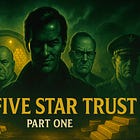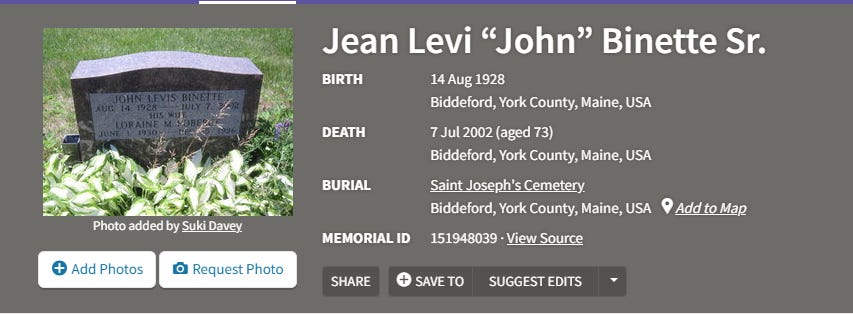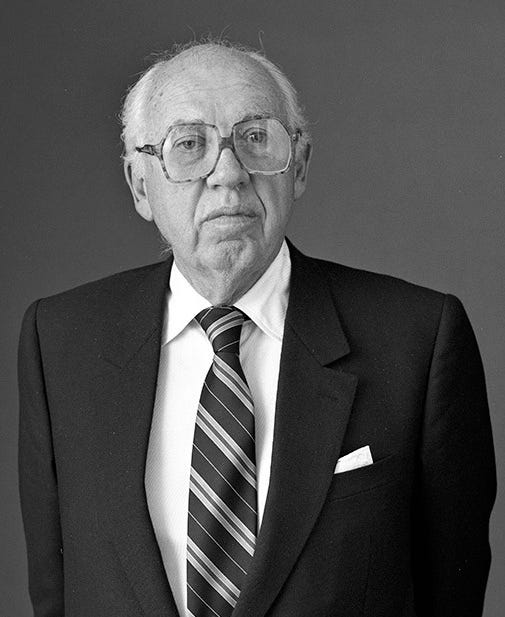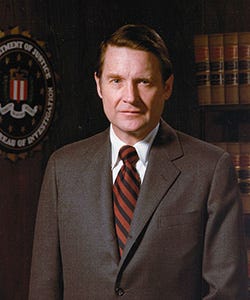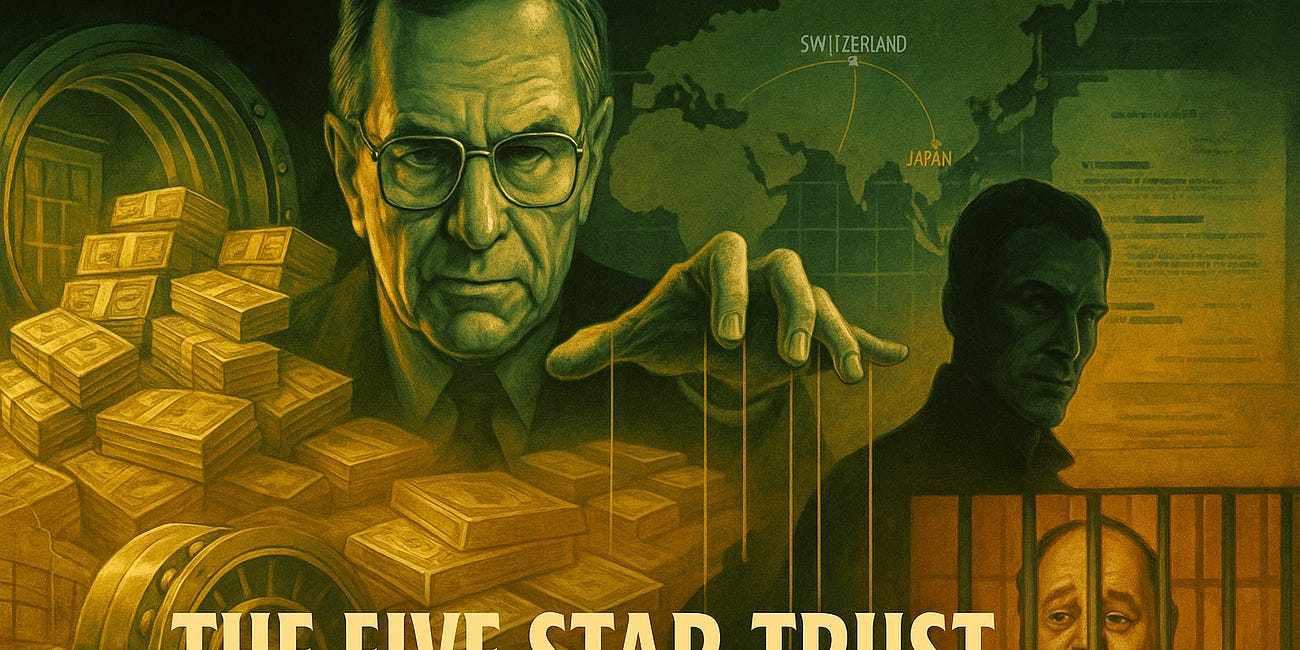The Five Star Trust: Loose Ends (Part 2/5)
The CIA needed funding for the Contras—so they resurrected Operation Eagle II under a new name. But they first needed to wrap up the loose ends. All of them.
Catch up with Part 1 Here:
Everything was supposed to end quietly.
In 1976, the CIA’s most dangerous black-budget operation—Eagle II—was winding down. Billions had already moved through Japanese banks. An operation called STUDEBAKER had been started to launder the funds.
A low-profile businessman named Marion “J.R.” Horn had stepped in as the final piece. And a Certificate of Deposit from Mitsui Bank, worth ¥318 billion yen, had been validated by U.S. officials and placed in his hands.
It was all set to disappear. No press. No trace. No oversight.
Then came Nicaragua.
Richard Helms needed fast, untraceable cash to fund the Contras—and Congress wasn’t playing ball. The CIA didn’t just need money. It needed a system. So, rather than build a new one, Helms resurrected the old machine.
Eagle II was reborn, rebranded as Golden Triangle, and handed off to Richard Armitage—with full support from Vice President George H.W. Bush, but behind Ronald Reagan’s back.
One problem remained:
Marion Horn still had the CD.
And if that certificate moved through the international banking system, the whole shadow operation—Studebaker, Eagle II, the Japanese slush fund, and Bush’s role in all of it—could be exposed.
So they set him up.
They labeled the certificate a forgery. They called it stolen. They handed his file to the Singapore CID. And on November 21, 1983, they moved in.
But someone got to Horn first.
SINGAPORE: THE SETUP
On November 21, 1983, the trap was sprung.
While in Singapore, Horn and his associate John Burns were detained by the country’s Commercial Crimes Division.
No doubt, Horn was scared. After all, this is the country that still had caning.

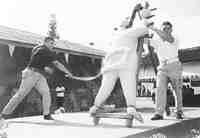
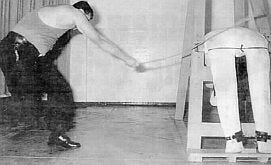
All documentation—including the CD, letters of validation, and consular statements—were confiscated on the spot.
Official reports called the CD a fake.
Unofficially?
Singapore had just helped bury a global black op.
“All papers confiscated and everyone (except lizuka, who was a participant with the government) [would] be lost in jails in the Far East forever. No trace…no records.”
— FBI File
It would’ve worked.
Except for one thing.
Jailbreak
To this day, no one except Horn knows who intervened.
But Horn walked.
He wasn’t executed.
He wasn’t black-bagged.
He wasn’t even charged.
Instead, he slipped out of Singapore—with his life, and more importantly, his memory of what had happened.
The CIA had nearly succeeded.
But now, there was a visible footprint.
Horn had been detained.
The papers had been seized.
And the story couldn’t be erased completely.
The paper trail was getting larger.
ARMITAGE’S TRIPLE CROSS
The Singapore sting didn’t end the problem.
It multiplied it.
Horn was free. The CD existed. And the paper trail was now distributed across three countries, four agencies, and at least two governments.
But while Helms was scrambling to manage the fallout, someone else was taking full advantage of the chaos:
The Man Who Wouldn’t Share
By 1984, Armitage wasn’t just a cog in the machine.
He had become the machine.
Installed as Assistant Secretary of Defense for International Security Affairs, Armitage had the ultimate cover: Pentagon clearance, intelligence community access, and no public profile.
Golden Triangle ran through him.
The guns to the Contras, the heroin from Southeast Asia, the laundering circuits—it all came back to his desk.
And he wasn’t just following orders anymore.
He was building his own empire inside the CIA’s empire.
According to the leaked FBI file:
“Mr. Armitage has become the consummate double dealer and the perfect ‘triple-crosser.’”
He wasn’t just operating for the Agency.
He was running operations that:
Fed CIA black budgets
Secretly enriched Bush-era allies
And diverted funds into private holdings under gold-backed proxy accounts
The Bureau estimated that over $100 billion was siphoned and stashed—most of it converted to gold bullion, hidden across banks in the Pacific Rim (Singapore, Hong Kong, Malaysia, Taiwan, and The Philippines).
Golden Triangle Wasn’t About the Contras Anymore
Initially, the rebirth of Eagle II as Golden Triangle was about funding Nicaragua.
But Armitage changed that.
He turned a covert op into a private central bank for U.S. shadow policy.
Heroin wasn’t just funding war.
It was funding everything:
Foreign elections
Private arms development
Off-the-books real estate
Blackmail networks
And massive kickbacks to powerful political families

But it was too late.
Because Armitage wasn’t following Helms anymore.
And the only two people who could stop him?
Marion Horn.
And Robert Ferrera.
HORN’S INSURANCE POLICY
The Singapore sting failed to neutralize him.
The banking blacklist didn’t silence him.
And now, Marion Horn was angry—and wary.
If the CIA wanted to destroy him, he wasn’t going down alone.
Learning from Colby
Though they may have never met, Horn took a page from William Colby—a man who knew too much and trusted too little.
Colby had survived by crafting an “insurance policy”:
Secret recordings
Duplicate files
Memos stored in multiple jurisdictions
So Horn did the same. He started copying documents.
Circulating timelines.
And most importantly—talking to the FBI.
Or so he thought.
Enter: John Binette
In 1988, Horn reached out to a man he believed was the answer:
John Binette, a “retired” CIA agent from Biddeford, Maine.
The document even goes as far as to state his last known address is listed as:
“60 Adams Street, Biddeford, Maine”
And sure enough, there was a John Binette that lived in Biddeford, Maine.
So, Horn wanted someone who could investigate the State Department, validate his documentation, and maybe—just maybe—help him clear his name and reclaim the Mitsui CD.
Binette presented himself as that guy.
An old CIA agent with connections. Someone who could move between the shadows of government bureaucracy without raising red flags.
But Binette wasn’t retired.
And he wasn’t loyal to Horn.
According to the leaked FBI memo, Binette immediately reported back to the Agency. Even the Bureau was aware of him and exploited him whenever they wanted to get information:
“We [the FBI] simply have people say to [Binette] that they are CIA agents and they need his help—and he spills.”
Horn thought Binette was helping him build leverage.
In reality, Binette was handling him.
The Lawsuit
Still believing he could work within the system, Horn took a bold step.
He sued the U.S. Department of State, demanding the return of the Mitsui CD as rightful property of his company:
U.S. Mortgage & Trust Co., Inc.
His attorney?
Willard C. McBride.
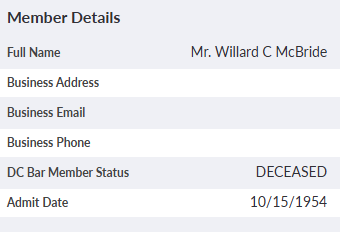
The lawsuit was real. The claim was documented. And the paper trail was tight.
Horn had:
A consular validation from the U.S. Embassy in Japan
Original witness signatures from Mitsui Bank
Confirmation of deposit from the Japanese Treasury
And multiple notarized copies
But it wasn’t enough.
The claim was denied by the Department of State on March 21, 1986, on grounds that the consular officer (Frances T. Lide) had only performed a standard notarial act to authenticate signatures on October 19, 1983, and there was no evidence of negligence or liability under the FTCA. No subsequent court case appear to have been filed, as FTCA claims must typically be pursued in federal court within six months of denial if unresolved, and no records of such litigation exist
Now things were getting uncomfortable.
As the FBI Document states:
“Horn started to make too many waves and he enlisted the help of many influential indvidiauls, including a friend of the Director of the Bureau, Mr. Alan Woofly. A decision was made, and that decision was that Marion Horn, Jr., and the U.S. Mortgage and Trust Co., had to be stopped.”
— FBI Document
The Blacklist Strategy
The CIA couldn’t have the paper trail grow any larger.
So they changed the battlefield.
Instead of fighting Horn in a courtroom (because how can you fight with documents that don’t exist), they attacked his identity.
“He had to be silenced, and the best manner of so doing was to fully discredit him.”
His name was added to Interpol’s “persona non grata” list
He was flagged in international banking systems
Major financial institutions were informed that Horn was “associated with a fraudulent CD”
His access to legal counsel, wire services, and travel was limited overnight
But they wanted more. They needed to absolutely destroy his reputation.
So Helms made one last call.
He brought Ferrera back.
And lied to him.
THE RETURN OF FERRERA
General Robert L. Ferrera.
The ghost.
The fixer.
The one man who could walk into any room in the world and walk out without a trace. They wanted dirt on Horn and Ferrera (the only one who had a connection with the Singapore government) was the only one who could get it done.
To bring him back, Helms had to create a fiction—one tailored specifically for Ferrera’s sense of loyalty and justice.
He told Ferrera that Marion Horn was dirty.
That he was trying to steal funds from the government. Worse, Helms said, Horn was working for the FBI.
Ferrera had spent years protecting the Agency from rogue elements, internal leaks, and international exposure. The idea that someone like Horn—an outsider—might be weaponizing black-budget intelligence against the CIA?
It triggered every red alarm in Ferrera’s mind.
Ferrera agreed to help.
But only if he could handle it personally.
What The Agency didn’t count on?
Ferrera was already suspicious.
Ferrera’s Investigation
The former member of the “Gang of Five” didn’t trust easily. So he started investigating.
And he found out everything.
Ferrera found the names of FBI agents within the CIA, as well as their agents embedded in U.S. Embassies abroad. And he gave all the information to his “very good friend”, William Casey (then Director of the CIA).
It’s no surprise that William Casey and Roberto Ferrera were close. They were cut from the same cloth.
Both had served in the Office of Strategic Services (OSS) during World War II. Casey had run Secret Intelligence in Europe, while Ferrera operated in some of the darkest corners of Asia and the Balkans.
After managing Reagan’s 1980 campaign, Casey was rewarded with the top seat at Langley. But he didn’t want to just manage intel. He made it clear from the start:
He would only accept the role if he could shape foreign policy, not just report on it.
Reagan agreed.
And just like that, Casey became the most powerful DCI since the Cold War began—a cabinet-level operator with real authority, a blank check, and Reagan’s personal backing.
Under Casey:
The CIA’s budget exploded
Human assets were deployed at Cold War levels
Post-Watergate restraints were dismantled
Covert influence over foreign governments was once again on the table
This wasn’t just the CIA’s comeback.
It was the resurrection of the OSS.
And Casey didn’t forget his old friends.
But, with the FBI now being exposed by Ferrera, the Bureau had a new enemy: Ferrera.
The Reverse Uno Card
While Ferrera was out trying to gather Intel to destroy Horn’s reputation, William H. Webster, the director of the FBI at the time, set out to destroy Ferrera’s reputation.
The FBI forged forged the name of Horn’s attorney, Willard McBride, as well as other signatures and documents, to implicate that it was actually Ferrera who was trying to sell the Certificate of Deposit for his own personal gain. They used three guys who Ferrera had previously “aided back on their feet” and were sure that their plan would work.
But then again…this is Ferrera.
“We have never been sure as to why this mission of ours failed, but it did.”
Now Ferrera, knowing the FBI was on his case, was thoroughly convinced Horn really was working with the FBI.
So he doubled his efforts to destroy Horn.
You Don’t Burn Jason Bourne
In the words of the leaked FBI file:
“Now all took a turn…This came about because Ferrera kept digging and digging, and the more he dug, the more he became convinced that Horn was an innocent victim who had been used by the agency (which was true), and that Horn was as big a ‘Red, White and Blue’ patriot as could be found. Ferrera was by now convinced that Horn was simply a super entrepeneur who had managed to out-hustle the hustlers.”
Evidently Ferrera took a strong liking to Horn, similar to a “father-son” bond, and he was protective.
As the file previously stated:
“Ferrera had, and still has, the reputation of being totally ruthless and without mercy when he feels that he has been betrayed, or when he feels one of his very few friends have been betrayed.”
Bottom line:
Don’t fuck with Jason Bourne.
THE FERRERA SOLUTION
After realizing Horn had been framed, Ferrera tapped his personal network—and his personal bank account. FBI files show Ferrera spent over half a million dollars of his own money (equivalent to over $1.5 million today) to begin an aggressive campaign to both protect and legitimize Horn.
He didn’t throw that money around carelessly.
He weaponized it.
Gifts, Gratitude, and Global Influence
Ferrera’s genius was in the optics. He purchased luxury gifts worth tens of thousands of dollars—artwork, jewelry, diplomatic antiques—and sent them to some of the most powerful individuals in the world. The gifts were accompanied by formal letters of appreciation, attributed to Horn himself, thanking each recipient for their support in “resolving the Studebaker matter.”
Recipients included:
Baron Luis deMonchey, Chief Justice of the World Court of Justice (likely Manfred Lachs, Chief Justice from 1973-1976)
Three Japanese Prime Ministers
The Speaker of the House of Commons in England
Key judicial, banking, and diplomatic figures across Singapore and the Pacific Rim
The message was clear: Horn was the good guy. He was the benefactor. He was the gentleman patriot cleaning up a historical mess—not the criminal CIA was painting him to be.
Ferrera’s benevolence did more than turn heads. It rewrote the narrative.
Masterstroke: The Five Star Trust
But Ferrera didn’t just clean up Horn’s mess. He cleaned up the CIA’s problem too.
He came up with the idea for the ultimate financial sleight-of-hand: The Five Star Trust.
This trust was an engineered front organization, designed to serve three covert purposes:
Launder the Mitsui CD
The infamous Certificate of Deposit (No. 4051100-92) linked to STUDEBAKER was deemed "stolen" and a forgery by the Japanese government and Mitsui Bank. But Ferrera found a way to breathe new legitimacy into it by creating a financial entity with just enough credibility to handle high-value transactions—and just enough opacity to escape regulatory scrutiny.Shield Horn from Legal Repercussions
All future funds tied to the CD would now be filtered through the Five Star Trust, making Marion Horn merely a trustee to the trust—not a direct recipient. This gave him plausible deniability, protected him from IRS seizure, and distanced him from any accusations of fraud.Create a New Intelligence Asset Hub
Internally, Five Star Trust became a ghost-bank of sorts—offering financial “face-saving” services to former CIA-friendly regimes, laundering funds from South American regime changes, and reactivating black budget routes that the CIA could no longer afford to run in-house.
According to the leaked FBI report:
“All IRS taxes have been forgiven to a phony front trust, called ‘Five Star Trust,’ that has been set up as a cover for Horn… The Bureau has tried to investigate this… but we have met with stone walls. Horn and Ferrera are now considered ‘untouchables.’”
— FBI Document
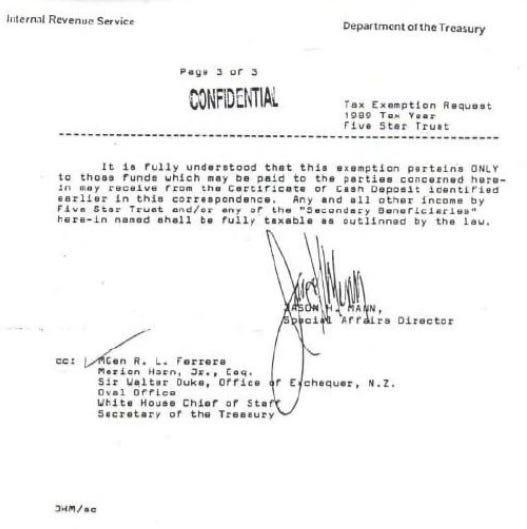
Additionally, the Department of Justice and the State Department issued orders to halt all inquiries, shred documentation, and treat any mention of Horn or Ferrera as classified obstruction.
This isn’t surprising since this is during Reagan and Bush years that this was going on. The Attorney General during those years (Dick Thornburgh) met George H.W. Bush when Bush was director of the CIA, and he was the US Assistant Attorney General for the Criminal Division. George Shultz (the Secretary of State) had correspondence with both Helms and Colby while he was Secretary of the Treasury.
Coincidentally, Shultz, post-government, was associated with Bechtel Corporation (1974–1982 and after), which employed former CIA Director Richard Helms as a consultant and had ties to CIA-linked projects.

So, needless to say, in the same way Bush had destroyed any CIA documentation of Eagle II, he effectively destroyed any federal pursuit of STUDEBAKER.
THE FIVE START TRUST GROWS
The name itself would appear to be a nod to the original Gang of Five—Helms, Colby, Bush, Armitage, and Ferrera—who built the engine of CIA’s black budget empire. But unlike the shadowy offshore vehicles used in Eagle II, Five Star Trust was built for cleanup.
It was a vault for liabilities and loose ends. Ferrera, in effect, constructed a Trojan Horse inside the financial intelligence world—one that allowed Horn to walk free, get his money, and hold leverage over the very institutions that once sought to erase him.
Over time, the CIA brought all their black budget bank accounts under the single umbrella of Five Star Trust in the name of Marion Horn. These accounts are described as subsidiaries or sub-entities of the trust, including ties to U.S. Mortgage and Trust Company (Bahamas) Ltd. and over 825 foreign bank accounts on the "international banking grey screen" (a term for off-the-books financial systems).
So what exactly happened to the funds?
How much is in there?
Are they still using it?
And who was this former CIA “general” who spent his own fortune protecting a Kentucky entrepreneur?
Stay tuned for Part 3: Black Money
Frequently Asked Questions (FAQs)
1. Was the Mitsui CD real—or a forgery?
Officially, the CD was labeled a forgery by Mitsui Bank and the Japanese government. But here's the twist: it was validated by U.S. officials, stamped by the American consulate, and backed by witness signatures—before it was ever declared fake.
So was it real?
Let’s put it this way: if it wasn’t real, the CIA wouldn't have tried so hard to erase every trace of it.
2. Why was Marion Horn targeted?
Because he wasn’t supposed to be a loose end.
Horn was the final link in a black-budget pipeline called STUDEBAKER. He had possession of the ¥318 billion yen CD—a smoking gun. And when Richard Helms needed to re-spin the machine to fund the Contras, Horn’s existence became a threat.
So they tried to erase him.
The problem? He survived.
3. Who was Robert Ferrera—and why did he help Horn?
Ferrera was a CIA legend. OSS veteran. Founder of the Green Berets. Co-architect of Eagle II. And one of the only men powerful enough to say "no" to the Agency and walk away alive.
When he realized the CIA framed Horn, he used his own fortune to protect him—to the tune of $500,000+ (equivalent to $1.5 million today).
Ferrera didn’t just save Horn. He flipped the board.
He was the architect of the Five Star Trust.
4. What was the Five Star Trust really?
A cleanup crew disguised as a bank.
Five Star Trust wasn’t just financial camouflage. It was a Trojan Horse, designed to:
Legitimize the Mitsui CD
Protect Horn with legal distance
Serve as a covert laundering engine for U.S. black ops
At its peak, it reportedly controlled hundreds of shadow accounts across the Pacific Rim, run by former CIA allies and backstopped by gold-backed collateral.
Even the IRS issued it a tax exemption, something no fake entity ever gets.
5. So… what happened to the money?
Short answer: no one knows.
Long answer: there are rumors of $1.6 trillion at Credit Suisse, $135 billion at Barclays, and 60,000 metric tons of gold parked under layers of shell entities from Panama to the Philippines.



